Based on the 12 Modules in the recent FAO Publication “Agricultural Extension in Transition Worldwide: Policies and Strategies for Reform”, the RD-TEC, Lamjung campus, Nepal organized a virtual cafe conversation in making undergraduates aware of the present state of extension service provision in the world in comparison to the one in Nepal. Mahesh Jaishi, Dinesh Nepal and Ashmita Acharya reflect on the event in this meeting note.
CONTEXT
Agriculture Extension Service is now considered to be at a crossroads globally. Many questions are raised on the discipline and significance of agriculture extension. Rapid growth of agricultural information and technology has generated pressure on reformation of the agriculture extension system. In spite of the many challenges, extension system is essential for agricultural development and social reformation. This Café Conversation was conducted to address national and international agriculture extension reform and to provide students with an opportunity to explore and learn about the different facets of the extension program.
DESIGN OF THE PROGRAM
The conversation was organised for the students of the Institute of Agriculture and Animal Science (IAAS), Lamjung, Nepal, in virtual mode using MS teams. Discussion was based on the 12 modules laid out in the book, Agricultural Extension in Transition Worldwide: Policies and Strategies for Reform” (https://www.fao.org/3/ca8199en/CA8199EN.pdf ) prepared by Magdalena L. Blum, Francesca Cofini and Rasheed Sulaiman V (2020), edited by Lawrence T, and published by the Food and Agriculture Organization of the United Nations (FAO). An open invitation posted on the official webpages of Research Development-Training and Extension Center (RDTEC), Lamjung and Ubjani, attracted a large number of participants. Agriculture Development Strategy expert, Mr Min Prasad Budhathoki, was the Chief Guest along with Assistant Campus Chief of Lamjung Campus (IAAS) Mr Mahesh Jaishi, Campus Chief of Khaireni Campus (IAAS) Mr Milan Subedi, and Assistant Professor of Rampur Campus (AFU) Mr Ram Hari Timalsina as important guests.
KEY CONVERSATIONS FROM THE PROGRAM
Trends in Extension Reform
Present trend in Global Extension System
The extension service system of today is seen to be moving towards pluralism where multiple actors, such as private sector, INGOs, NGOs and other agribusinesses, etc., are working to provide extension services. The present extension system is more sensitive towards the problems and demands of farmers apart from transfer of technology, and is more market oriented. The various extension systems such as Conventional Extension System, Training and Visit System, Tuki Extension System, Block Production Program, and Group Approach were implemented in Nepal at various times.
From this Conversation the following thematic areas came up as necessary for the future of extension:
- Agriculture Innovation System (AIS);
- Community extension system;
- Agri-entrepreneur service center;
- Women participation in extension;
- Social media utilization for agriculture extension;
- Value chain extension;
- Agri-business oriented extension system.
Pluralistic and Demand Driven Rural Advisory Systems
A Pluralistic Service system supports the co-existence of multiple actors, public, private and civil society service providers, and offers various types of services and have diverse financial sources.
The major advantages of a Pluralistic extension system are:
- Utilization of different extension approaches rather than focusing on a single approach;
- Helping overcome the weaknesses of a single agency extension system as it focuses on the strong sides of the various actors;
- Providing services by considering gender, age, education level, skills and entrepreneurship capability of the recipients, and also helping to provide and utilize information from diverse sources.
The factors that affect the effectiveness of a Pluralistic Service System are:
- Coordination among the different actors;
- Participation of a large number of stakeholders;
- Quality assurance;
- Capacity building of the actors involved;
- Coverage and capturing benefits of the various actors involved.
The Nepal Agriculture Policy (2004) has recognized the extension system practiced in Nepal as a Pluralistic Extension System. Even though the number of service providers is increasing by the day, the extension system is not as effective as it should have been. The major cause for this is lack of coordination among the actors. One of the methods in which this limitation can be managed is through the encouragement of a demand-driven RAS.
The demand-driven approach of advisory system makes farmers proactive seekers in which the farmers and producer organizations (POs) demand the specific extension service they need. In demand-driven RAS, services are driven by user demand, service providers are accountable to the users, and users have a free choice of service providers. Demand-driven RAS identifies demand and supply side of advisory system. Farmers and POs are the demand side who have the power to identify and choose which advisory services are needed by them, choose between service providers, negotiate services, and also evaluate the service provided.
POs are crucial on both demand and supply side of RAS. In several European countries (Denmark, Finland, France and Germany), producer associations carry out extension with partial government sponsorship. Some examples of POs providing RAS are:
- National Smallholder Association in Malawi and commercial farmers’ union in Namibia provide a wide range of RAS and other support services to their members;
- In India, the Maharashtra State Grape Growers Association regularly conducts group discussions and seminars for grape cultivators, and publishes leaflets and booklets covering different topics on grape cultivation and disseminates them among grape cultivators.
POs also play an advocacy role by enhancing their members’ interests and by influencing policy formulation to improve RAS so as to ensure that the voices of farmers are represented.
Various producer organizations are active in Nepal. The Farmer Managed Irrigation System (FMIS) is the oldest producer organization of Nepal under whose management falls 70% of irrigated land in Nepal. Similarly, some of the other successful producer organizations are Nepal Coffee Producers’ Association (NCPA) and Community Based Seed Production (CBSP). These producer organizations have successfully established themselves and are currently serving their members by conducting the programs they demand and by advocating their members’ interests.
Programs such as One Village One Product (OVOP), One District One Product (ODOP), Project for Agriculture Commercialization and Trade (PACT), etc., are some of the examples of extension services provided through the pluralistic mode of service delivery. OVOP and ODOP have been supported by the Government of Japan along with the Agribusiness Support Organization in Nepal. Similarly, PACT functions with support from the Nepalese government together with aid from various private organizations and other actors.
In line with the demand-driven system of extension service delivery, the LGOA-2017 (Local Government Operation Act 2017) promulgated in Nepal gives the authority and responsibility of implementing the service delivery system to the elected local governments. Under the 2015 Constitution of Nepal, Annex 6 and Annex 8 stated that all needs and priorities will have to be demanded from the government at the local level. This Act, though promulgated in 2017, has not been strictly implemented yet.
| Box 1: Case study of a high-tech nursery in Nepal In Suri-5, Gaurishankar rural municipality, of Province no. 3, Nepal, farmers felt the need for a high-tech nursery. They, through a cooperative, demanded establishment of a nursery with the local government. Then the province government along with the rural municipality, established a high-tech nursery with an investment of around two crore and twenty lakh rupees. Technical assistance is also provided to the farmers. Training on the management techniques for the high-tech nursery, as well as how to maintain and improve upon the production of the seedlings was provided to the farmers. This is one of the typical examples of a demand-driven RAS as the farmers themselves identified their need and demanded the same from the local government. The services provided were according to the needs and demands of the farmers and not according to what the officials may have felt. |
One of the important points to be considered is the financing of systems. In the pluralistic demand-led RAS system, funding is provided by both private and public sectors. In the context of Nepal, it is necessary to introduce the pluralistic demand-led RAS system so as to make farmers more productive, empowered, and also to reduce poverty.
Some international examples of different financing mechanisms are:
- Producer Cooperative (e.g., Narina Dairy Cooperative in Colombia): In this type of cooperative all the funds are raised by users as indirect fund through membership fees and levies from milk sales;
- Farmer Organization (e.g., DAAS [Danish Agriculture Advisory Service]): It consists of a national center and a local advisory center. It has moved towards 100% user payment system since 2004;
- Decentralized System (e.g., Agriculture Technology Management Agency in India): 90% of its fund is provided by the Central Government and the remaining 10% by the state government;
- Farmer Innovation Fund (e.g., Local Innovation Support Fund): This was promoted by PROLINOVA (Promoting Local Innovation in Ecologically Oriented Agriculture and Natural Resource Management, NRM). The proposal submitted by farmers are judged on certain criteria by the fund management committee and based on this judgment the innovation is funded.
In the context of Nepal, total sustainable financing is not feasible. But the method that was practiced in Chile can certainly be adopted where the farmers were divided according to their economic status. The farmers who have better incomes pay for themselves whereas the financing for the marginal farmers can be done by the government.
Inefficiency of the public extension service system has led to the increased importance of local government and other actors, including private dealers, NGOs, civil society, organizations and producer organizations who came in to provide advice to farmers. Even though this pluralistic RAS system is more responsive to farmers’ priorities, the public sector is also required to ensure that public goals are met (i.e., food security, poverty reduction, etc.) and nobody is left behind (social equity). An integrated approach is required with joint goals that can integrate interdisciplinary teams and other sources for greater impact. A system that is run by multiple stakeholders is found to be more flexible, time efficient, and responsive to farmers.
Mr Min Budhathoki (ADS expert) highlighted the following:
- Every approach adopted in Nepal – some of which are Pocket Package Approach, Farmers’ Field School Approach, Projectization Approach, etc. – has had its own plus points as well as limitations. Lack of consideration of Nepal’s socioeconomic system is a major reason for not getting the expected results from different approaches.
- Nepal has been depending heavily on donors for financial support and so the approaches adopted have been largely influenced by the preferences of the donors.
- The demand of the farmers is very diverse today. The public sector as a single actor of extension service provision is unable to satisfy the demands of the farmers and so this has led to the evolution of Pluralistic Service System in Nepal.
- RAS, in itself, is not very profitable, and hence doesn’t attract many private firms.
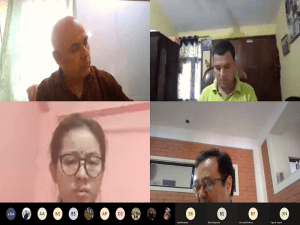 Chief Guest Mr Min Budhathoki providing his insights on the extension system of Nepal.
Chief Guest Mr Min Budhathoki providing his insights on the extension system of Nepal.
Linking Farmers to Markets
Most of the stakeholders in Nepal sell their produce at a farm gate or local markets. This has hindered the farmer from getting good prices as intermediate traders and other stakeholders in the chain take a large share of their produce and their benefits. To overcome this problem, linking farmers to the market is very important. It is a key to reduce rural poverty and hunger. Linkage can be done by both informal (based on trust) and formal (contract) ways. Different sectors such as NGOs, INGOs, public sector, private sector, POs, rural advisory service providers, agriculture advisory service providers, etc., can get involved in linking farmers to markets and can also help them by providing current marketing information.
Guest speaker Dr Mahesh Jaishi explained why extension services should move towards becoming a demand-driven system as because huge expenditure of resources happens when there are no indicated target groups. This blanket approach of providing the same extension services to all farmers without considering their needs has cost stakeholders a huge amount of resources without substantial positive outcomes to show for it. If RAS and other services are delivered according to the specific demands of the farmers the loss of resources can be minimized while meeting the demand of the farmers – thus making the service provision system much more effective. Adding to it, Mr Min Budhathoki, added the need to focus on two aspects:
- What kind of service has been demanded?
- Are the technicians capable of providing those services?
The technicians should have the capacity to address the needs of the farmers. If the farmers feel that the advisors do not have the capacity to provide the services they need, then the farmers might find greater incentive in acquiring information from other tools such as social media and various apps, rather than from these advisors.
While trying to link farmers to the market, consideration of the type of farming system that these farmers actually practice needs to be taken. The average landholding of Nepalese farmers is around 0.5 ha. Most of these farmers follow a semi commercialized system of farming. In such cases, it would be beneficial for the farmers to focus on cooperative farming and cooperative marketing. The extension system will certainly have to be tied to the market to address the current needs.
ICT in Rural Advisory System and Services
Most farmers of Nepal do not use smart phones and consequently the apps and other social media platforms effectively. The unavailability of such phones in the rural area is one of the reasons why the use of apps and social media platforms is not an effective method of knowledge dissemination. Nowadays in Nepal various apps, such as ICT for Agriculture, Geokrishi and Smart Krishi, have also emerged as effective ICT tools for information dissemination on a wide range of agricultural activities ranging from the cultivation of field crops to livestock. Farmers of today have relatively greater access to mobile phones, TVs and radio. Television and radio programs are effective information sources for agricultural information dissemination. ‘Krishi TV’ is one of the channels that broadcasts knowledge on agriculture in Nepal. Government and private agencies that are active in Nepal use various ICT tools to reach a wider range of rural farmers. Numerous Facebook pages run by agriculture graduates and technicians have also been a source of information dissemination in the country. Because of such advancement in ICT tools, there is much scope for better information dissemination in the country.
Apps – such as Smart Krishi and Geo Krishi – are helping farmers a great deal in Nepal. While the e-choupal gives information mostly related to livestock, farmers have relatively greater access to mobile phones, TVs and radio than they did earlier. Hence these media can be used effectively for information dissemination. Recognizing this opportunity, apps such as Smart Krishi and Geo- Krishi have been launched in Nepal along with various programs that are broadcast through TV and radio.
But, the guest speaker Mr Milan Subedi, the Campus Chief of Khaireni Campus (IAAS), said that Nepal doesn’t have enough data and relies heavily on neighboring countries for the same, which is one of the main reasons why ICT tools in Nepal have not been able to attain their full potential. Mr Radeep Tandukar, Program Director at Geokrishi, highlighted that one of the major constraints Nepalese farmers face while adopting and utilizing ICT tools has been the unavailability of good quality smart phones in the rural areas, and also the lack of knowledge and skills on the farmer’s part to use such apps. Mr Ram Hari Timalsina, Assistant Professor of AFU, said that the advisory approaches and systems must be adopted and modified in accordance to the context of the country. The compatibility of the advisory approaches with the needs of the farmers and the situation of the country should be analyzed well for increased effectiveness. Internet has around 60% penetration in Nepal and so internet-based ICT tools should be encouraged.
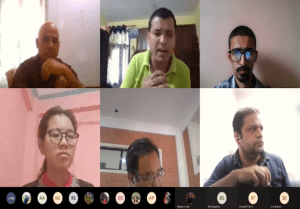 Guest speaker Asst. Prof. Ram Hari Timilsina’s feedback on the modules
Guest speaker Asst. Prof. Ram Hari Timilsina’s feedback on the modules
Gender-Sensitive Rural Advisory Systems and Services
The realization that agricultural extension and advisory services should be gender sensitive only entered into agricultural discourse during the early 1980s. An urgent need to develop the capacities of advisors and management training on ‘gender analysis’ and ‘gender-sensitive agricultural planning’ has been felt in today’s age. In examining gendered patterns of advisory services, it is important to consider ‘who’ and ‘how’ these services are delivered. The issue of whether or not women are recognized as farmers and legitimate clients of extension services is of utmost importance in today’s age. Challenges for achieving a gender-sensitive RAS include gaps in policy legislation and implementation, non- recognition of women’s contribution to the agricultural sector, and inequalities in employment, including in division of labor, workload and wages.
| Box 2: Women Empowerment – Case study of Patuwa village in Nepal In Patuwa village of Sarlahi district in Nepal, the women previously spent a great deal of their time in carrying water from the river to their home. UN Women, Food and Agriculture Organization, along with the International Fund for Agriculture Development, then installed an irrigation channel in Patuwa which helped provide free time for the women of this village. The women began investing their free time in the fields alongside their male counterparts. Women were also provided with various trainings which have led to good results in terms of productivity of the land and overall farming profitability. These women were also utilized as trainers to impart their knowledge to women of neighboring districts. The extension of this program has encouraged better women’s participation in these areas to a huge degree. |
Mr Budhathoki discussed the effective strategies to increase gender sensitization in extension provision systems which includes major points: a) the involvement of female advisors; b) development and use of technologies which help in drudgery reduction of women; c) involvement of women in post-production practices rather than focusing only on field work; and d) linking the women with the marketing sector as well.
According to Ms. Rita Gurung, if the problem of gender gap is to be tackled women themselves would have to cultivate a desire to lead. It has been observed that many women identify themselves as supporting members even when their contribution is as much, if not more, than the males in their family or society. This needs to change. One of the ways to address this issue can be by educating women.
Extension and Advisory Approaches and Methods
Advisory approaches incorporate a style of action embodied by extension philosophy which determine the direction and nature of various aspects such as structure, techniques, resources, etc., that are related to how extension advisory services are provided. The objectives for the formation of different advisory methods and approaches are to find and select best fit technology, to develop skill and knowledge, to empower innovation, and to link the producer to the market.
Managing RAS System and Organization
The effectiveness, efficiency and sustainability of advisory service providers is defined by its institutional strength. It also depends upon the performance and competitiveness of the service providers. When the service system is found to be weak in these areas, the services can certainly not be provided efficiently. With the increasing awareness among farmers, the needs and demands of today’s farmers is also quite different from the traditional ones. To address these needs the RAS system will also have to evolve.
Roles of AE/RAS that needs to be adopted in the recent context:
- The strategies, initiatives, agendas, current functions, and operational framework should be reconsidered, revisited and updated;
- RAS should work with multiple actors, thus creating a unified front to address the global challenge of climate change;
- RAS should also perform intermediary role.
Capacity Development of RAS
One of the ways in which RAS can enhance its capacity is by supporting agricultural innovation and developing various teaching and training materials on the different issues that they need to tackle. For example, in 1994 Aftab Banglamukhi Farm Limited (ABFL) in Bangladesh partnered with various NGOs and extended credit facilities, poultry feed, veterinary supplies to the farmers and also helped organize sales. This partnership shouldered around 90% of the production cost while only 10% of the production cost was invested by the farmers. Furthermore, technical assistance for building poultry shed, poultry insurance and many market facilities were also provided by this partnership. This helped in better risk management for the farmers and also ensured family employment, thereby providing huge benefits to the farmer.
Challenges
The advisory method should be able to fulfill different interests and demands of the clients, and the approach should also be dynamic enough to be able to facilitate scaling up and modernizing of the existing information.
It should be able to efficiently manage the inputs and allowances provided in order to reduce the interdependency between clients, and should also be able to devise impartial programs that are not biased by the implementers’ and sponsors’ interests.
There has not been sufficient study in RAS in Nepal. However, we can certainly find the use of Farmer Field Schools under certain extension programs. A strong need to transform the extension delivery process from the traditional approach to the new approach is felt. The implementation of an AIS in extension service delivery is crucial today.
RAS in Agricultural Innovation Systems
The Agricultural Innovation System is a network of organizations, enterprises and individuals focused on bringing new products, new processes and new forms of organization into economic use, together with the institutions and policies that affect their behavior and performance, which contribute to the development, diffusion, and use of new agricultural technologies. Conceptually, AIS is comprised of four components: Research and Education, Business and Enterprises, Bridging Institutions, and Enabling Environment. The final outcome of investing in AIS should be strengthening the capacity for innovation.
The involvement of different actors, some of which are Krishi Vigyan Kendra, State Agriculture Teaching institutions, research stations, local farmers, etc., led to the successful adoption of the SRI system by the local farmers of Tripura State, thereby increasing the yield of rice by 16.5% in 2011. In a similar way, participation of various actors such as Farmer Field School, Department of International Development, International Maize and Wheat Improvement Centre, and other such institutions led to successful handling of replicated trial done under SRI in the year 1985 in Nepal.
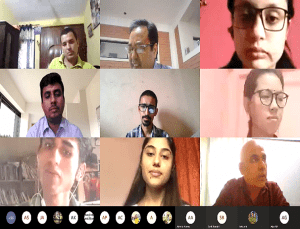 Student’s discussion on modules
Student’s discussion on modules
CONCLUDING NOTE
The program proved to be a great platform for the students to interact with the experts and learn from them. The need to move from the traditional method of extension to the new RAS system was highlighted. This program was also successful in making undergraduates aware of the present state of extension service provision in the world in comparison to the one in Nepal.
Acknowledgment
We thank Mr Min Budathoki, ADS expert, Mr Mahesh Jaishi, Assistant Professor of IAAS, Mr Milan Subedi, Assistant Professor of IAAS, and Mr Ram Hari Timilsina, Assistant Professor of AFU for the inputs provided by them. Finally, we acknowledge Mr Narayan Neupane, Campus Chief, Lamjung Campus, Mrs. Rita Gurung, Assistant Professor of IAAS, and Mr Radip Tandukar, Program Director at Geo Krishi for their valuable suggestions and support.
 Mahesh Jaishi, Assistant Professor, Institute of Agriculture and Animal Science (IAAS), Lamjung Campus, Nepal. He can be reached at maheshjaishi@gmail.com
Mahesh Jaishi, Assistant Professor, Institute of Agriculture and Animal Science (IAAS), Lamjung Campus, Nepal. He can be reached at maheshjaishi@gmail.com
 Dipesh Nepal is Editorial Director from Ubjani.Com. He can be reached at dipeshnepal65@gmail.com
Dipesh Nepal is Editorial Director from Ubjani.Com. He can be reached at dipeshnepal65@gmail.com
 Ashmita Acharya is a student, IAAS Lamjung Campus, Nepal. She can be reached at ashmitaacharya20@gmail.com
Ashmita Acharya is a student, IAAS Lamjung Campus, Nepal. She can be reached at ashmitaacharya20@gmail.com

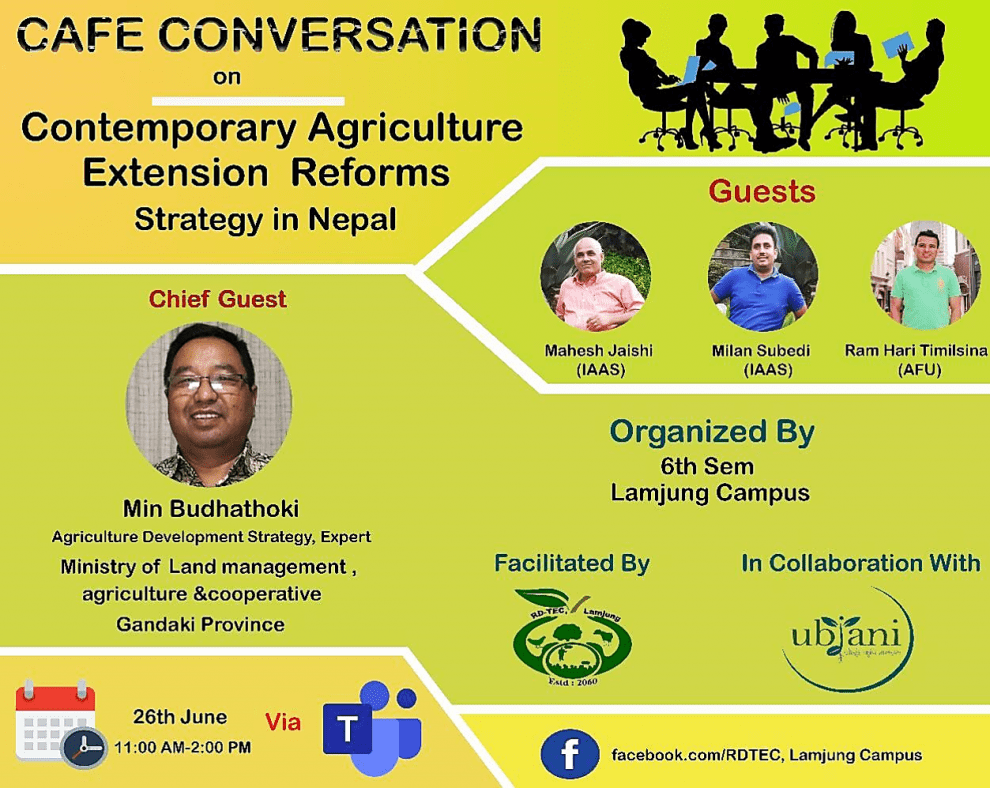

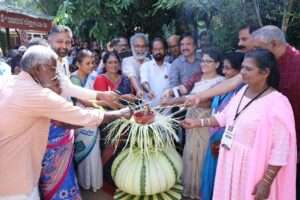

Add Comment